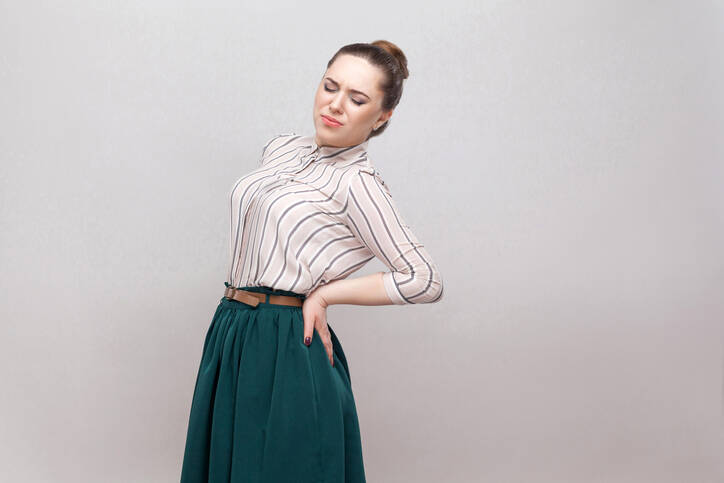- pennmedicine.org - 4 Reasons You May Have Back Pain on Only One Side
- healthline.com - What Causes Flank Pain and How to Treat It
- healthline.com - What's Causing Pain in My Lower Left Abdomen?
- medicalnewstoday.com - What causes flank pain?
The 10 main causes of hip pain: do you know them?

Dull, stabbing or burning pain in the hip is a common problem for a huge number of people. Just as each pain is different and specific, so too are its origins. Let's take a look together at the 10 most common reasons for hip pain.
Article content
Left or right?
Women can also experience it during pregnancy.
The search for the cause of the pain is made particularly difficult by the number of organs and systems involved, not only the digestive or excretory system, but also the musculoskeletal system.
Pain often overlaps. Many times the pain comes from a different place than where it is felt. Some pain is unpleasant but harmless. Others indicate a disorder, a disease.
1. Pain in the hip when running or other physical exertion
Pain in the hip of a stinging or cutting nature often occurs, for example, when running. It occurs especially in people who are not very accustomed to this physical activity.
When running, the liver and spleen are circulated in greater quantities. This causes a tightening of their sheaths, which leads to pain.
The diaphragm is a flat muscle that forms a partition between the chest and abdominal cavity. Several organs of the abdominal cavity are attached to it. These pull it downwards as a result of the shocks caused by running. However, the diaphragm also has to perform the important function of breathing and moves upwards with the exhalation.
This work of the diaphragm can cause the aforementioned cramps and sharp pain in the side, especially in untrained people. The correct breathing technique also has a great influence here.
This pain is not a symptom of a disease. It subsides when you stop the exercise. You can avoid this unpleasantness if you do not eat or drink for an hour before the activity and try to breathe properly during the activity.
2. Pain during ovulation
This phenomenon is experienced by about one in five women. A stabbing or cutting pain is described by some women in the left or right lower abdomen. It may spread to the whole side, even to the spine.
It is caused by the release of an egg from the ovary, which then travels into the fallopian tube, where it awaits fertilisation. We are talking about ovulation. It therefore occurs around the middle of the menstrual cycle during the so-called fertile days.
Rest and warm compresses help to relieve it.
However, if the pain is intense or you are in doubt, consult a doctor about the condition.
Other gynecological causes of pain in the lower abdomen:
- Ectopic pregnancy
- ovarian cysts
- inflammatory diseases
- venereal diseases
- Cancer
Read also the article.
3. Appendicitis
Inflammation of the appendix vermiformis, as it is professionally called, is a common cause of pain in the right flank.
This tubular structure is approximately 6-10 centimetres long and 7 millimetres wide. It is actually a protrusion of the large intestine, which has a free end. This is the reason why it is not always easy to diagnose, because it can easily change its position, which changes the typical symptoms of the disease or the pain travels to other areas of the abdomen or flank.
The function of the appendix is still not entirely clear.
Some theories claim that it is a reservoir of beneficial bacteria.
Others claim that it is a stunted relic from our evolutionary days.
Typical symptoms of appendicitis include nausea, vomiting, pain in the right lower abdomen and increased temperature.
Surgical removal is a common solution. It depends on whether the pain comes from irritation or a true inflammatory process.
Read more in the article.
4. Gallbladder stones
Pain related to digestion includes the so-called gallbladder attack. The gallbladder is a hollow organ that serves to collect and concentrate bile.
Many people mistakenly believe that bile is formed in the gallbladder.
However, the truth is that it is only stored there.
Bile is formed in the liver.
Bile is a fluid needed in the process of digestion of ingested food. The gallbladder therefore expels it into the small intestine when needed.
However, if there is a gallstone in the bile ducts, it forms an obstruction. The bile ducts are blocked, causing intense throbbing pain. This pain often radiates to the back, under the right shoulder blade or into the stomach area.
The provoking factor is especially fatty, heavy or fried food. Pain after eating can occur after half an hour or even later.
If you have gallbladder problems, avoid fatty and fried foods. Make sure you take in enough fluids. Eat more often, but smaller portions.
Alcohol, coffee and smoking will also do no good, nor will stress. Cramp-relieving drugs, herbal tea and warm compresses can help during a seizure.
Also read the article on gallstones and the article on gallbladder inflammation.
5. Kidney stones
A similar issue to gallbladder stones is encountered in connection with kidney stones. In this case also, the obstruction in the form of a stone causes pain.
These can be found in the kidney, ureter and bladder. They are formed from molecules of minerals, salts and other substances that are normally dissolved.
They cause pain in the side or back, often radiating to the groin and bladder. Accompanying symptoms include fever, blood in the urine and, of course, pain when urinating.
You can avoid the formation of bladder stones in particular by drinking enough and correctly.
You may also be interested in the article.
6. Ulcer disease
Ulcers of the stomach or duodenum represent irritation and damage to their inner side of the mucous membrane.
The origin is closely related to the disproportion between the acidic gastric juices and the low protective capacity of the mucous membrane. Basically, it is a so-called self-correction of the surface of the wall, by its own juices.
In contrast, duodenal ulcers are characterised by pain on an empty stomach.
The pain is dull, gnawing and most often occurs in the stomach area. It may radiate under the left rib arch (gastric ulcer) or the right rib arch (duodenal ulcer).
Many people do not have any significant discomfort and may not even know they have an ulcer.
It is typically seasonal.
Patients usually have more significant problems in spring and autumn.
Read also the article.
7. Pancreas
The pancreas is a gland that produces pancreatic juices, but also hormones.
The hormones insulin and glucagon ensure that blood sugar levels are correct.
The pancreatic outlet enters the duodenum, along with the gallbladder outlet. A common pancreatic disease is inflammation, which can have several causes. It often occurs along with inflammation of the gallbladder, in connection with gallstones. Another common triggering aspect is alcohol.
Pain caused by pancreatitis (inflammation of the pancreas) occurs mainly in the upper abdomen. It may radiate to the back and between the shoulder blades. It is intense and usually accompanied by nausea and vomiting.
The manifestations depend on whether it is acute (sudden) or chronic (long-term) pancreatitis.
Read more in the article on pancreatitis
8. Cirrhosis of the liver
This disease is known colloquially as hardening of the liver. It is the conversion of liver cells into tough connective tissue. This leads to impaired function and gradual death of liver tissue.
The cause may not be alcohol alone. There are also many other factors, such as medications or repeated inflammation of the liver.
Pressure pain in the area under the right rib arch is a symptom that appears only at a relatively advanced stage of the disease. At this stage it is often accompanied by nausea, yellow skin or even water in the abdomen - ascites.
You may also be interested in the article.
9. Intestinal disorders
Unpleasant pains can also arise because of excessive flatulence. Air passing through the intestinal villi can be a real pain, especially in the area near the spleen or liver.
The most common causes are inappropriate diet, stress, but also various functional digestive disorders. The pain is caused by gases that distend the intestine. They cause problems of various kinds.
You can learn more about excessive flatulence and its causes in the article on flatulence.
The most serious condition and complication that can occur when the organs in the abdominal cavity are disturbed is the so-called sudden abdominal episode.
This is a life-threatening condition that requires acute intervention.
The most common causes may be an accident, appendicitis, complications of an ulcer or other bowel or stomach disorders.
A brief overview of the possible causes of pain according to its location:
| left side | right side | the whole lower abdomen or any side of the lower abdomen |
| inflammation of the spleen | appendicitis | hernia |
| inflammation of the pancreas | gallbladder inflammation | ectopic pregnancy |
| diverticulitis | gallbladder stones | ovarian cysts |
| inflammation of the stomach | inflammation of the liver | ovulation |
| ulcer disease | cirrhosis of the liver | renal colic |
10. Locomotor system
Pain in the right or left side can also be caused by the spine, muscles or other musculoskeletal structures. Several disorders and problems of this kind are manifested by pain radiating to one or both sides.
Vertebrogenic algic syndrome is a term that encompasses several disorders involving the spine, all of which are accompanied by pain.
These can be functional disorders, structural changes, stretching, overstretching of muscles and ligaments, disc bulging and so on.
Perhaps the most common disorder, particularly in younger individuals, is the so-called back spasm - known professionally as lumbago. This sudden onset of pain stems from spasmodic contraction of the muscles and tendons that surround the spine.
The pain is intense, uncomfortable and often makes movement impossible. It can shoot not only into the sides and limbs, but even into the chest.
Read more not only about this spinal problem in the article: vertebrogenic algic syndrome.
Other causes of hip pain originating in the musculoskeletal system include overuse, trauma or sciatic nerve inflammation.
Read about other possible causes in the article.
Interesting resources










